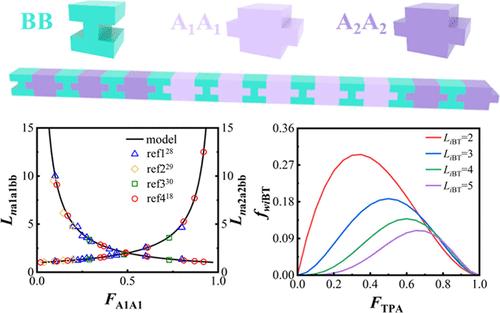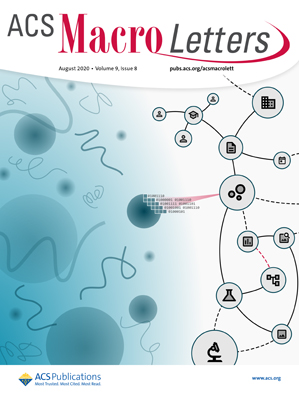无规共聚物链序长度和分布建模
IF 5.1
Q1 POLYMER SCIENCE
引用次数: 0
摘要
无规共聚聚酯的性能和特性(包括生物降解性、机械和热特性、透明度等)受其链结构的影响很大。然而,获取详细的链序列信息仍是一项重大挑战。本研究介绍了一种基于概率方法的数学模型,用于确定无规共聚聚酯的序列长度和分布。研究重点是两类共聚物,即代表聚(己二酸丁二醇酯)(PBAT)的 A1A1BB-A2A2BB 和以聚(丁二酸丁二醇酯-聚乙二醇酸)(PBT-PGA)为例的 A1A1B1B1-A2B2。根据模型得出的各种共聚物的预测序列长度与文献报道的数值十分吻合。从模型中获得的链序分布可以更好地了解共聚物的独特性质。据观察,在共聚聚酯链中加入羟基酸单元可在不改变共聚物组成的情况下有效缩短链序长度,这为在保持无规共聚聚酯机械性能的同时提高降解性能提供了一种策略方法。当共聚物成分在 0.7 至 0.9 之间时,数均序列长度的影响尤为显著,含有羟基酸单体单元的共聚物需要更高的共聚物成分。该模型为研究人员提供了一个强有力的工具,使他们能够更深入地了解无规共聚聚酯中共聚物组成与其结构特征之间的关系,并促进高性能无规共聚聚酯的开发。本文章由计算机程序翻译,如有差异,请以英文原文为准。

Modeling of Chain Sequence Length and Distribution in Random Copolyesters
The performances and properties of random copolyesters, including biodegradability, mechanical and thermal properties, transparency, etc., are highly influenced by their chain structures. However, obtaining detailed chain sequence information remains a significant challenge. This study introduces a mathematical model based on a probabilistic approach to determine the sequence length and distribution in random copolyesters. Two types of copolyesters, A1A1BB-A2A2BB, representing poly(butylene adipate-co-terephthalate) (PBAT), and A1A1B1B1-A2B2, using poly(butylene succinate-co-glycolic acid) (PBT–PGA) as an example, are the focus. The predicted sequence lengths of various copolyesters derived from the model are in good agreement with the values reported in the literature. The chain sequence distribution obtained from the model provides better insights into the unique properties of the copolyesters. It is observed that the incorporation of hydroxyl acid units into copolyester chains effectively reduces the sequence length without altering the copolymer composition, offering a strategic approach for enhancing degradation performance while maintaining mechanical properties of random copolyesters. The influence of the number-average sequence length becomes particularly significant when the copolymer composition ranges between 0.7 and 0.9, with a higher copolymer composition required for copolyesters containing hydroxyl acid monomer units. This model represents a powerful tool for researchers, enabling a deeper understanding of the relationship between copolymer composition and its structural characteristics in random copolyesters and facilitating the development of high-performance random copolyesters.
求助全文
通过发布文献求助,成功后即可免费获取论文全文。
去求助
来源期刊
CiteScore
10.40
自引率
3.40%
发文量
209
审稿时长
1 months
期刊介绍:
ACS Macro Letters publishes research in all areas of contemporary soft matter science in which macromolecules play a key role, including nanotechnology, self-assembly, supramolecular chemistry, biomaterials, energy generation and storage, and renewable/sustainable materials. Submissions to ACS Macro Letters should justify clearly the rapid disclosure of the key elements of the study. The scope of the journal includes high-impact research of broad interest in all areas of polymer science and engineering, including cross-disciplinary research that interfaces with polymer science.
With the launch of ACS Macro Letters, all Communications that were formerly published in Macromolecules and Biomacromolecules will be published as Letters in ACS Macro Letters.

 求助内容:
求助内容: 应助结果提醒方式:
应助结果提醒方式:


